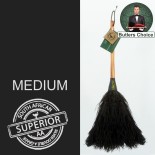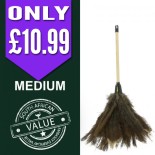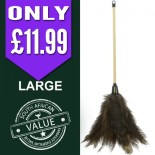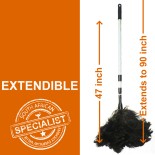Shopping Cart
0 item(s) - £0.00Feather History
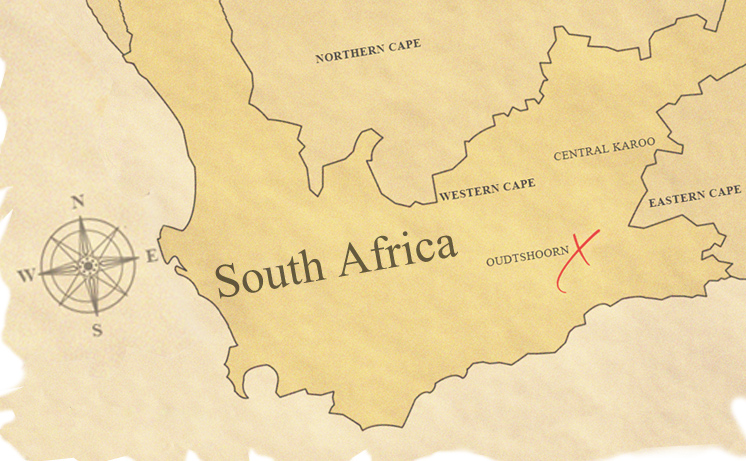 On the southern most tip of Africa lies a town called Oudtshoorn, The Ostrich Capital of The World, where Ostriches have roamed the plains of the southern cape for centuries.
On the southern most tip of Africa lies a town called Oudtshoorn, The Ostrich Capital of The World, where Ostriches have roamed the plains of the southern cape for centuries.
The first European explorers to the area were a trading party led by Ensign Shrijver who were guided there by a "Griqua" via an ancient elephant trail in January 1689. The expedition reached as far as present day Aberdeen before turning back and exiting the Klein Karoo valley through Attaquaskloof on the 16 March in the same year.
The history of Oudtshoorn is directly connected with the growth of the ostrich feather industry from as early as 1860. By the turn of the twentieth century the use of prime ostrich feathers in ladies clothing was the height of fashion, particularly in the UK and Europe where they were especially popular for use on the latest fashionable hats.
Between 1875 and 1880, ostrich prices reached up to £1000 per breeding pair, at one point the precious feathers were worth more than their own weight in gold! The farmers of the region, quickly realised that ostriches were far more profitable than any other activity, ripped out their crops and planted Lucerne.
Mr Scholtz, the Magistrate of Oudtshoorn, first introduced Lucerne to South Africa by importing the seed and planting a small field to feed his ostriches. The birds thrived on this diet and soon after many farmers started planting Lucerne.
 Max Rose - During the high point of the feather trade Oudtshoorn was a hub of activity, this was one of the reasons why 300 Jewish families emigrated from Lithuania to the town, which at that time carried the nickname "Little Jerusalem". Amongst these immigrants was Max Rose, who arrived in 1890 and had such good fortune that after only 10 years he become the unrivalled feather baron in the whole of South Africa.
Max Rose - During the high point of the feather trade Oudtshoorn was a hub of activity, this was one of the reasons why 300 Jewish families emigrated from Lithuania to the town, which at that time carried the nickname "Little Jerusalem". Amongst these immigrants was Max Rose, who arrived in 1890 and had such good fortune that after only 10 years he become the unrivalled feather baron in the whole of South Africa.
The feathers were light and easily exported and fetched incredibly high prices. The resulting prosperity had a profound effect on Oudtshoorn and it's surrounding area. Towards the end of the nineteenth century Oudtshoorn profited unlike any other town in the world from a fashion trend which went back to the Art Nouveau movement : the use of ostrich feathers.
Ostrich Feather Palaces
 The farming community, who had suddenly become extremely rich, vied with each other to display their wealth and built magnificent "Ostrich Feather Palaces" decorated and embellished with stained glass windows, turrets and handsome cast-iron work (locally known as "brookielace").
The farming community, who had suddenly become extremely rich, vied with each other to display their wealth and built magnificent "Ostrich Feather Palaces" decorated and embellished with stained glass windows, turrets and handsome cast-iron work (locally known as "brookielace").
A number of well known architects such as Charles Bullock, George Wallace and J.E. Vixeboxse opened offices in Oudtshoorn and were responsible for the design of many an Ostrich Palace.
Several of the "Ostrich Feather Palaces" are still to be viewed in Oudtshoorn. The distinctive sandstone used for these buildings was readily available because it was locally quarried. The skill of the Scottish stonemasons, who had originally been offered work building the Dutch Reformed Church is evident in these fine buildings.
The Domesticated Ostrich
Oudtshoorn is now recognised by Germany's Munich-based Institute of Palaeo-anatomy, as the place where ostriches were domesticated - the modern domestic ostrich was bred from a cross between South Africa's indigenous bird, the South African Black, and the Evans-Lovemore strain of Barbary blue-necked ostriches (141 of which were secretly smuggled out of North Africa and brought to Oudtshoorn by a group of adventurers under the leadership of RW Thornton of the Grootfontein Agricultural College). The story of Mr Thornton and his team reads like the story board from a Hollywood blockbuster, filled with danger and excitement. And these birds are regarded as the nucleus of the common domesticated South African Ostrich.
The Ostrich Feather Duster
 South African ostrich feather dusters were developed in Johannesburg, South Africa by missionary, broom factory manager, Harry S. Beckner in 1903. He felt that the Ostrich feathers made a convenient and most efficient tool for cleaning up the machines at the broom factory.
South African ostrich feather dusters were developed in Johannesburg, South Africa by missionary, broom factory manager, Harry S. Beckner in 1903. He felt that the Ostrich feathers made a convenient and most efficient tool for cleaning up the machines at the broom factory.
His first ostrich feather dusters were wound on broom handles using the foot powered kick winders and the same wire used to attach broom straw. And from that day forward the Ostrich Duster has gained the formidable reputation as the world most powerful Duster used by millions of satisfied consumers the world over!
By 1905 the Ostrich Duster was the must have item in many a household and were sold in ever increasing numbers which saw the introduction of the (Ostrich Bird feather duster salesman! )
These dashing salesmen were the top of their game and made a very good living traveling from town to town selling Ostrich dusters door to door, in-fact these duster were so popular many other travelling salesmen like, Bible Salesmen soon started selling Ostrich Feather Dusters so they could make some extra money.
Ostrich Dusters And The Automotive Industry
According to BMW's Munich Factory in Germany, the most important part of a cars finish is the paint shop, the cleanest section of the factory.The workers wear dust-free, lint-free overalls from head to toe. To get the best finish , a car's shell must be completely spotless before it gets painted. And to ensure this is the case , Every car gets dusted down by an amazing machine that gently strokes it all over with Ostrich feathers.
The machine responsible for doing this looks like a bizarre car wash, but with feathers in place of the more conventionally used sponges.
BMW claims it gets six months use out of the high quality feathers even though they are in full production six days a week- before they are replaced with another set. Only the ostrich feather carries a natural negative charge, attracting any stray dust particles, which naturally carry a natural positive charge.
Ostrich dusters are used exclusively by Museums and Art Galleries throughout the World as the softest and most efficient way of maintaining their exhibits and works of art. Ostriches are now farmed in more then 40 countries around the world, however it is industry recognised that when it comes to Feather Quality, Oudtshoorn sits proudly as the worlds leader.
Embassy Ostrich Feather Dusters are proud to be a part of the amazing story of Gods greatest bird... the South African Ostrich.
The Ostrich
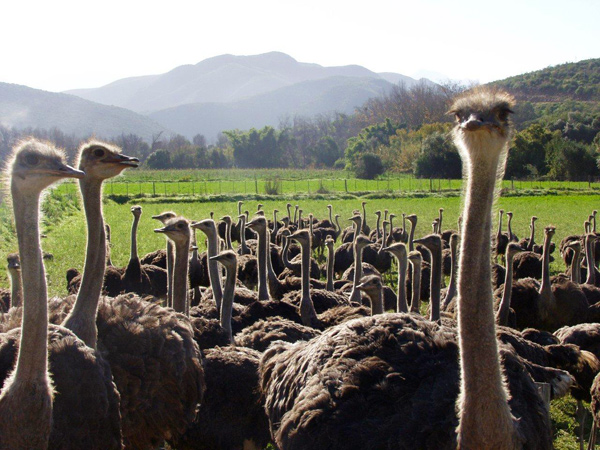 One must ask the question, but what of the ostrich? Todays domesticated Bird has never had it so good. These truly amazing animals are loved and relished in South Africa, but nowhere more than Oudtshoorn, for they have played such an important part of its history that the Ostrich has become woven in to the fabric of the community, not only because of the creation of the wonderful Ostrich Palaces, an industry, employment not to mention wealth. The Ostrich has probably never had such a profound effect on any environment in the entire world and have earned such respect from the farming community.
One must ask the question, but what of the ostrich? Todays domesticated Bird has never had it so good. These truly amazing animals are loved and relished in South Africa, but nowhere more than Oudtshoorn, for they have played such an important part of its history that the Ostrich has become woven in to the fabric of the community, not only because of the creation of the wonderful Ostrich Palaces, an industry, employment not to mention wealth. The Ostrich has probably never had such a profound effect on any environment in the entire world and have earned such respect from the farming community.
There are 2 main sorces of ostrich feather.
1, Ostriches moult twice a year, the skills handed down over the generations have developed into highly skilled Ostrich handlers walking through groups of birds and gently remove the lose feathers to make way for new ones without panicking the birds in perfect harmony with their environment, the feathers are then washed and graded and placed in sacks and stacked all ready for the next feather auction. At this point our South African partners bid and secure the very best feathers and transport them to the factory for processing and production of our Highest Quality Dusters.
2, Ostrich meat is one of the most healthy types of meat there is as it contains almost no colesteral and is widely eaten all over Africa, Europe and the Americas. As leather is a buy product of beef and pork, feathers are a by product of the ostrich.
Copyright ©2015 Embassy OFD Ltd. | All rights reserved | VAT No. 140 4770 34 (Registered in the United Kingdom)
EMBASSY OFD LTD, HORIZON HOUSE, 1 TYOCK INDUSTRIAL ESTATE, ELGIN, MORAYSHIRE, IV30 1XY. | Company No. SC428753







